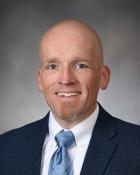Your upper heart chambers, the atria, need their space. That’s why, as babies develop in the womb, a wall of tissue called the atrial septum forms to separate the atria. Sometimes, however, a hole remains in the barrier. Known as an atrial septal defect (ASD), this hole in the heart is a type of congenital heart disease, which is a heart problem you’re born with. At the UK Gill Heart & Vascular Institute, our team helps adults from across Kentucky manage atrial septal defects so they can thrive.
Normally, the atrial septum prevents blood from flowing from the left side of the heart to the right. If you have an atrial septal defect, however, oxygen-rich blood from the left atrium can enter the right atrium, where it meets oxygen-poor blood. This can stress the right side of the heart and cause extra blood to enter the blood vessels leading from the heart to the lungs. As a result, the pressure in the arteries between the heart and lungs may increase and cause pulmonary hypertension, which is high blood pressure in the lung arteries.
Not all atrial septal defects are a cause for concern. Small defects, for example, may not cause symptoms or complications. If you have a large defect, surgery or a minimally invasive ASD repair procedure can treat it.
You may not have any symptoms if you have a small atrial septal defect. On the other hand, a large hole in the heart may cause:
- Heart murmur detectable with a stethoscope
- Heart palpitations (feeling like your heart is pounding)
- Shortness of breath during physical activity
If you had surgery to close an atrial septal defect as a child, you’re unlikely to experience complications related to the condition as an adult. Similarly, if you’re diagnosed with a small hole in the heart as an adult, it may not have much effect on the organ’s function, and you may not need treatment. A large defect, however, may need repairing.
Your prognosis depends on a variety of factors, including the size of the atrial septal defect, your symptoms, whether you have another congenital heart defect and your overall health. In some people, atrial septal defects can cause other cardiovascular complications. The right side of the heart may enlarge, for example, potentially leading to heart failure. An atrial septal defect may also increase the risk of atrial fibrillation or stroke in some people.
In general, if you have a minimally invasive procedure or surgery to repair an atrial septal defect as an adult, your prognosis is good. You likely won’t need additional treatment.
In most cases, the reasons atrial septal defects occur aren’t clear. Genetic changes and certain environmental factors the mother may be exposed to during pregnancy may contribute.
Children with congenital heart disease become adults with congenital heart disease (CHD). Ninety percent of children born with CHD have a normal life expectancy due to improved surgical interventions and better medical management. At all ages, close monitoring and expert care for CHD patients are essential. Despite this, studies indicate that 2 out of 3 young adults with CHD don’t transition from pediatric to adult CHD care. Not getting continued cardiac care can lead to a variety of health problems and poor outcomes.
To guide teens and their families through the transition, UK Gill Heart & Vascular Institute team members talk about the transition early and often. Starting at age 15, teens with CHD begin transition education. One Wednesday every month, a special transition clinic staffed by adult congenital heart disease providers, is held to meet with teens and their families to discuss important topics, including:
- Abilities and limitations experienced as an adult with CHD
- Lifelong need for proper CHD monitoring and treatment
- What adult CHD care may involve over the years
Additionally, once you transition to adult care with the Adult Congenital Heart Program at UK Gill Heart & Vascular Institute, we work hard to enable you to keep your appointments and testing on track. We also work hard to empower you with knowledge and assist you in being your best advocate to live your best life. If you miss an appointment, we will call to reschedule.
During your first visit to the UK Gill Heart & Vascular Institute’s Adult Congenital Heart Program, you’ll meet our clinic nurse, social worker and other members of your care team. You’ll also undergo imaging exams, which may include an echocardiogram or a cardiac MRI.
Once imaging is complete, you will meet with an adult congenital cardiologist and other team members for up to one hour. You’ll discuss the results of your echocardiogram and your health history and symptoms. You will also get in-depth education about your diagnosis, how it may affect you moving forward and possible treatment options. The meeting is also a great opportunity to ask any questions about living with CHD.
When coming to your appointment:
- Bring a list of any medications or supplements you take and surgeries you’ve undergone.
- Dress comfortably.
- Have your insurance information on hand. UK HealthCare accepts most insurers, and financial assistance is available.
- You may want a family member or friend with you to take notes or help ask questions.
Where we are located
The UK Gill Heart & Vascular Institute is located at 800 Rose St. in Pavilion G, on the first floor of UK Albert B. Chandler Hospital. We will mail you a map and directions when your appointment is scheduled.
Patient drop-off
Patients can be dropped off in front of the main entrance to Albert B. Chandler Hospital at 1000 S. Limestone. If you are dropped off at the main entrance, you’ll enter the revolving doors on the ground floor of the hospital. Take the main stairs just to the left (or elevator across the atrium) to the first floor of Pavilion A.
After climbing the stairs or taking the elevator, turn left. You’ll pass the Kentucky Wall and Kentucky Children’s Hospital on your right. Continue to the end of the hall until it comes to a T shape. Turn left and the Gill clinic entrance is across from an open area housing the organ donor wall.
Parking
It is easiest to park in the UK HealthCare Parking Garage, across from the hospital at 110 Transcript Ave.
There are two paths from this garage to the Gill clinic:
- You may take the free shuttle from Level A of the parking garage. You’ll exit the shuttle at the Pavilion A/ Pavilion G stop in front of the main entrance to the hospital. After climbing the stairs or taking the elevator, turn left. You’ll pass the Kentucky Wall and Kentucky Children’s Hospital on your right. Continue to the end of the hall until it comes to a T shape. Turn left and the Gill clinic entrance is across from an open area housing the organ donor wall.
- From Level C of the parking garage you may walk or take a golf cart across the pedway to the first floor of Pavilion A. Turn left past the help desk and walk away from the dining hall. You’ll pass the Kentucky Wall and Kentucky Children’s Hospital on your right. Continue to the end of the hall until it comes to a T shape. Turn left and the Gill clinic entrance is across from an open area housing the organ donor wall.
If you need help finding your way, information desks are located inside the main entrances to Pavilion A, both on the ground floor and at the end of the pedway on the first floor. You may also call the information desk at 859-323-5816.
Clinical trials provide access to novel treatments for those in the adult CHD program at UK Gill Heart & Vascular Institute. Through our Cardiology Clinical Research Center, patients benefit from advances in valve replacement and other therapies before they become standard treatment. Your care team will notify you if you qualify for an ongoing clinical trial.







